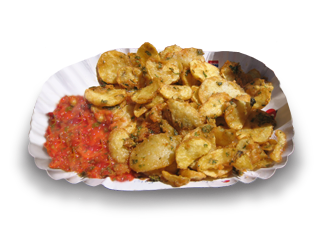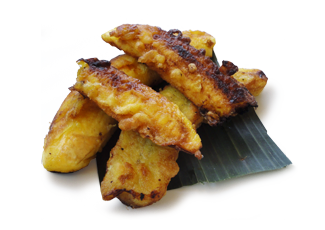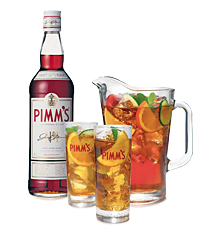Jane Pinto's Recipes
Pinto Family Potato Bhajias
When the children were young, we often marveled at how well they behaved whenever we entertained. When moments before Anna had been racing down the halls and Dennis had been riding his bicycle in the dining room, as soon as I announced that guests would be arriving shortly they became angelic.
Naturally, this caused us to entertain as much as possible! Years later I mentioned this to the children, and Dennis said “Mom, it’s because you only served Bhajias when we had company—we just wanted to make sure we were around for our favourite snack.” Mystery solved!
Thus Bhajias have become our daughter-in-law Joy’s favourite party food, and the treat we prepare every time our children and grandchildren come to visit. So in part we have Bhajias to thank for our love of entertaining friends and family—including you!

Ingredients
8 to 10 medium sized potatoes
2 cups gram* flour
1 ½ half level teaspoons salt
2 tablespoons chopped coriander
1 level teaspoon turmeric powder
1 ½ cups of cold water
Oil for deep frying
*Flour made from chickpeas—available at Indian and Asian specialty stores. Also, gluten-free!
Directions
Wash and peel the potatoes, then cut them into thick slices. Put all the slices in a large bowl full of cold water and set them aside while you prepare the batter. Sift the gram flour in a large bowl, then add the salt, coriander, turmeric and cold water and mix it all into a smooth paste, a little thinner than pancake batter.
Cover the bottom of a deep frying pan in about two inches of oil and begin to heat it on a medium-high flame. Pat the potato slices dry with towel and then dip them into the batter. You can also use the batter to test the oil—let a drop fall in, and if the oil is hot enough it will float up immediately. Reduce the heat to medium flame.
Place one batter-coated slice at a time into the pan, so that the slices don’t stick together. Place slices in this way until the pan is full, and cook each batch for about seven minutes, turning often with a slotted spoon.
When lightly browned, lay them out to drain on newspaper or a paper towel. The Bhajias should be golden brown and crispy on the outside and soft on the inside.
Serve hot or cold with tomato chutney (and a cold bottle of gingery Stoney Tangawizi when you’re in Kenya.) This is the perfect dish for entertaining, but if you have children around be wary—if you turn your back for a moment there won’t be any Bhajias left!
Jessun’s Fried Bananas
Our beloved cook, Jessun, often let Dennis ride on the back of his bike—Jessun would drop him off at school on his way to the market. As Jessun pedaled past the Nairobi National Park, Dennis would barely glance at the giraffe gracefully keeping pace or the elephant lumbering by—he was always too busy plotting with Jessun what his after-school snack would be.
Despite the lengthy conversations, nine times out of ten the long-anticipated snack was Fried Plantains. From childhood to fatherhood, it’s been one of his favourites, and now, some forty years later, his children savour them at teatime when they stay with me in Nairobi.

Ingredients
4 bananas (not too ripe) or plantains*,
each sliced lengthwise into
2 long halves
1 cup all-purpose flour
1 cup rice flour
1 tablespoon sugar
1/8 teaspoon salt
1 ½ cups water
3 cups canola oil
*Available at specialty South American or African food stores, as well as some mainstream grocery stores.
Directions
In a large bowl combine the all-purpose flour, rice flour, sugar, salt and water. This should form a thick liquid similar to pancake batter.
In a thick-bottomed pan heat the oil until it smokes lightly. Dip each slice of banana (or plantain) into the bowl of batter and then carefully submerse them in the oil. Each side should fry for approximately five minutes, then flip and fry for about another four minutes.
Once the bananas are golden brown, remove them from the oil and drain them on a sheet pan lined with newspaper or paper towels.
When all the bananas are all fried, you can arrange them on a platter. They should be eaten immediately, with tea or coffee, but that’s something we never have a problem with—as soon as the rest of the house smells them cooking, you’ve got a full kitchen!
Cocktail Hour Favourite: Pimm’s Cup
As a young couple in Nairobi, Felix and I would often gather with friends and family on Saturday afternoons at the Ngong Racecourse to cheer on the horses. Of course the experience was never complete without a Pimm’s Cup—we’d cheers our glasses if our horses won… and drain them if they lost!
Pimm’s Cup has been a cocktail of choice ever since. It was only when discussing it with a guest from the United States recently that I realized that not everyone knows about this delicious treat, which was invented by an oyster bar owner in London in the 1800s and swiftly traveled with the explorers of the day to East Africa and India. Pimm’s No. 1 Cup—a gin drink flavoured with liqueurs and fruit extracts—was an answer to the bitterness of straight gin, and a bartender’s quick solution to mixing such a complex cocktail multiple times for a packed bar.
There are many different ways to prepare a Pimm’s Cup. Neat is Felix’ favourite, but I prefer a Pimm’s summer cocktail. Sipping this cool beverage while lounging in a chair on a hillside, watching my grandchildren play as the sun sets, splashing red and gold across the wild bush landscape—that’s the life for me.

Pimm’s for Safari
(On safari, steps 1-3 will be performed by your camp bartender, of course!)
- Fill a pitcher with ice.
- Mix 1 part PIMM’S No.1 with 3 parts chilled lemonade;
add wild sweet mint, a handful of sliced cucumber and a few wedges of orange - Stir and pour into a tall glass.
- Sit back, sip, and sigh. You’re in Micato’s Africa

15 West 26th Street, New York, NY 10010 • tel: 800-MICATO-1 • 212-545-7111
fax: 212-545-8297 • Inquiries@micato.com • www.Micato.com